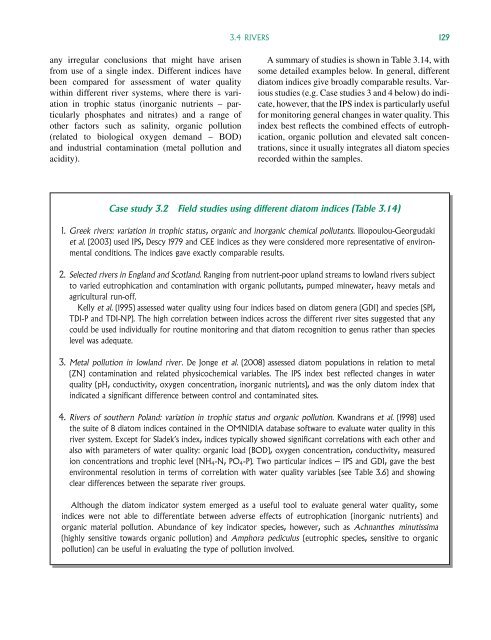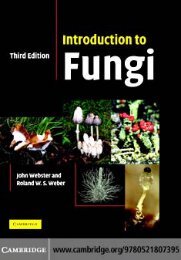Freshwater Algae: Identification and Use as Bioindicators
Freshwater Algae: Identification and Use as Bioindicators
Freshwater Algae: Identification and Use as Bioindicators
You also want an ePaper? Increase the reach of your titles
YUMPU automatically turns print PDFs into web optimized ePapers that Google loves.
3.4 RIVERS 129any irregular conclusions that might have arisenfrom use of a single index. Different indices havebeen compared for <strong>as</strong>sessment of water qualitywithin different river systems, where there is variationin trophic status (inorganic nutrients – particularlyphosphates <strong>and</strong> nitrates) <strong>and</strong> a range ofother factors such <strong>as</strong> salinity, organic pollution(related to biological oxygen dem<strong>and</strong> – BOD)<strong>and</strong> industrial contamination (metal pollution <strong>and</strong>acidity).A summary of studies is shown in Table 3.14, withsome detailed examples below. In general, differentdiatom indices give broadly comparable results. Variousstudies (e.g. C<strong>as</strong>e studies 3 <strong>and</strong> 4 below) do indicate,however, that the IPS index is particularly usefulfor monitoring general changes in water quality. Thisindex best reflects the combined effects of eutrophication,organic pollution <strong>and</strong> elevated salt concentrations,since it usually integrates all diatom speciesrecorded within the samples.C<strong>as</strong>e study 3.2 Field studies using different diatom indices (Table 3.14)1. Greek rivers: variation in trophic status, organic <strong>and</strong> inorganic chemical pollutants. Iliopoulou-Georgudakiet al. (2003) used IPS, Descy 1979 <strong>and</strong> CEE indices <strong>as</strong> they were considered more representative of environmentalconditions. The indices gave exactly comparable results.2. Selected rivers in Engl<strong>and</strong> <strong>and</strong> Scotl<strong>and</strong>. Ranging from nutrient-poor upl<strong>and</strong> streams to lowl<strong>and</strong> rivers subjectto varied eutrophication <strong>and</strong> contamination with organic pollutants, pumped minewater, heavy metals <strong>and</strong>agricultural run-off.Kelly et al. (1995) <strong>as</strong>sessed water quality using four indices b<strong>as</strong>ed on diatom genera (GDI) <strong>and</strong> species (SPI,TDI-P <strong>and</strong> TDI-NP). The high correlation between indices across the different river sites suggested that anycould be used individually for routine monitoring <strong>and</strong> that diatom recognition to genus rather than specieslevel w<strong>as</strong> adequate.3. Metal pollution in lowl<strong>and</strong> river. DeJongeet al. (2008) <strong>as</strong>sessed diatom populations in relation to metal(ZN) contamination <strong>and</strong> related physicochemical variables. The IPS index best reflected changes in waterquality (pH, conductivity, oxygen concentration, inorganic nutrients), <strong>and</strong> w<strong>as</strong> the only diatom index thatindicated a significant difference between control <strong>and</strong> contaminated sites.4. Rivers of southern Pol<strong>and</strong>: variation in trophic status <strong>and</strong> organic pollution. Kw<strong>and</strong>rans et al. (1998) usedthe suite of 8 diatom indices contained in the OMNIDIA datab<strong>as</strong>e software to evaluate water quality in thisriver system. Except for Sladek’s index, indices typically showed significant correlations with each other <strong>and</strong>also with parameters of water quality: organic load (BOD), oxygen concentration, conductivity, me<strong>as</strong>uredion concentrations <strong>and</strong> trophic level (NH 4 -N, PO 4 -P). Two particular indices – IPS <strong>and</strong> GDI, gave the bestenvironmental resolution in terms of correlation with water quality variables (see Table 3.6) <strong>and</strong> showingclear differences between the separate river groups.Although the diatom indicator system emerged <strong>as</strong> a useful tool to evaluate general water quality, someindices were not able to differentiate between adverse effects of eutrophication (inorganic nutrients) <strong>and</strong>organic material pollution. Abundance of key indicator species, however, such <strong>as</strong> Achnanthes minutissima(highly sensitive towards organic pollution) <strong>and</strong> Amphora pediculus (eutrophic species, sensitive to organicpollution) can be useful in evaluating the type of pollution involved.
















